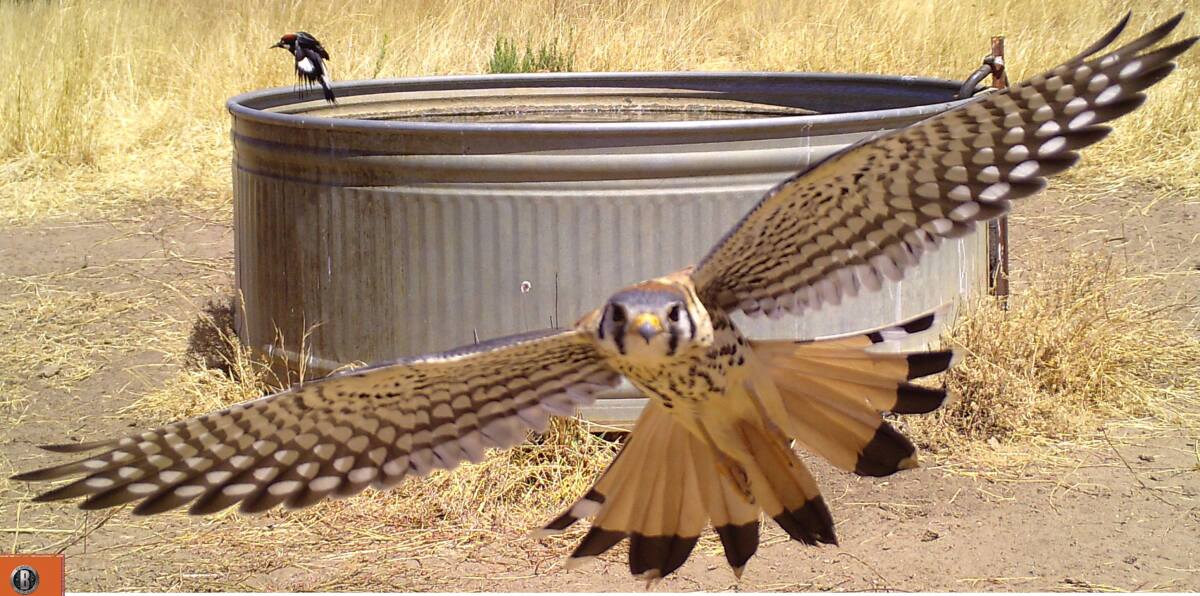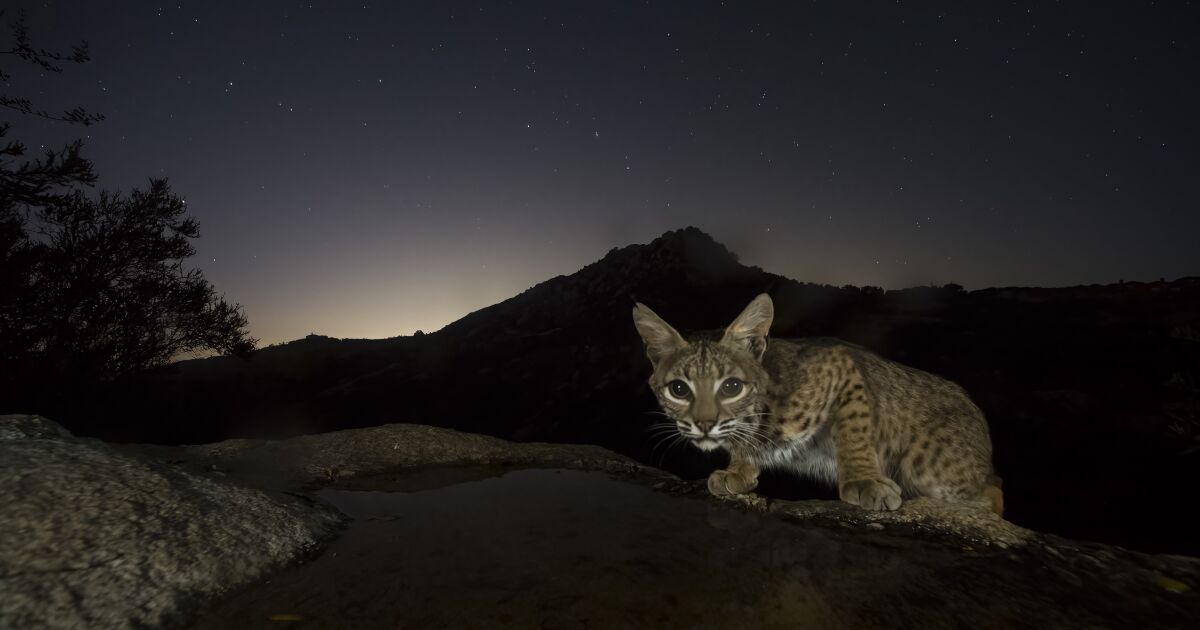[ad_1]
They need to stay hydrated, just like us. They are also fans of the shortcut, the evening stroll and the midnight snack, just like us. And when you surprise them with a sudden candid-camera moment, they look a wee bit guilty, even when they are clearly doing absolutely nothing wrong.
And we all know what that’s like.
From a bobcat taking a water break on photographer Roy Toft’s property in Ramona to a short-eared owlcaught mid-bath in the Antelope Valley by photographer Roy Dunn, the subjects of the San Diego Natural History Museum’s new exhibit, “Caught on Camera: Wildlife When No One’s Watching,” are busy doing their thing on our turf.
But as these photos of Southern California wildlife taken by motion- or heat-detecting cameras remind us, these suburban yards and public thoroughfares are not really our turf at all.
“That’s what the heart of the exhibit is,” said exhibit developer Abigail Karkenny.“It’s really about the ways that people and animals are sharing space. Even when we don’t see them or hear them or think about them, they’re always there.”
On display in the museum’s top-floor photography gallery, “Caught on Camera” — which opens Nov. 18 — is divided into three sections, each devoted to a different type of camera-trap photography.
There are the stunning, artfully lit shots caught by camera-traps set up by professional photographers like Toft, Dunn and by the late Tony Mercieca, a skilled amateur nature photographer whose close-up triptych showing how bats drink while flying will take your breath away.
My, what pointy teeth they have.
Another wall features purpose-driven photos taken by researchers from the Natural History Museum and other organizations for studies on how climate change affects the San Bernardino flying squirrel and how wildlife use a highway underpass in Irvine. There are also many camera-trap photos of the Shaw’s agaveplants at the Cabrillo National Monument, which were taken during a study of the pollination mystery surrounding the rare succulent.
And finally, there are the fleeting images of our wildlife neighbors captured by their human counterparts.

This action photo of an American kestrel was caught with a camera trap by James and Marilyn McFadden. The photo was taken in the mountains of East San Diego.
(James and Marilyn McFadden / The San Diego Natural History Museum)
A flat-screen monitor within the exhibit displays a rotating gallery of camera-trap photos submitted by people from around San Diego County. The current stars of this homegrown collection include a ringtail (a member of the racoon family) photographed in the Anza-Borrego Desert State Park by Richard Chadwick; an American kestrel caught in midflight in East San Diego by James and Marilyn McFadden; and a greater roadrunner chilling outside the Escondido home of Union-Tribune outdoors columnist Ernie Cowan.
Whether it is Dunn’s glowing photo of a pair of young mountain lions lapping up some water in Antelope Valley, or researchers’ cameras catching a coyote casually strolling past a graffiti-covered underpass wall, all of the photos on exhibit serve the same Natural History Museum goal of advancing conservation and celebrating San Diego’s incredible biodiversity.
“You can’t protect something unless people know about it. That’s why, instead of 20 photos of coyotes, we wanted to have coyotes and bobcats and ringtails and flying squirrels and as many different things as we could fit into this show,” Karkenny said.
“With the bat photos, people were just amazed to see that sense of motion, and to see the bat taking a sip of water. That is something you would never get to see with your own eyeballs. And sometimes, it’s the eye contact, especially with the mountain lions and the bobcat. Getting the chance to kind of look into their eyes and feel that connection, people just love that.”
The “Caught on Camera” exhibit will be on display for at least 18 months, but that doesn’t mean it will never change. In the interest of science, conservation and human fascination, the museum will continue to display “wildlife selfies” from members of the public.
If you have captured an stellar animal moment on your own camera trap or security device, by all means submit it using the form on the museum’s “Caught on Camera” exhibit page. Your photo could end up in the exhibit’s rotating flat-screen gallery, which the museum plans to update every quarter.
You could be another link in the chain of sharing and caring that could make the world a better, wilder place.
“When you see a skunk or a possum or a lizard in your yard, you build empathy with it. It becomes your neighbor. You respect it and you want to protect it,” Karkenny said.
“I hope that’s what people take out of the community section. I hope that they see these animals truly as the creatures we are sharing space with, and that they know we have a connection with them.”
“Caught on Camera: Wildlife When No One’s Watching” opens Friday, Nov. 18, at the San Diego Natural History Museum, 1788 El Prado in Balboa Park. Go to sdnhm.org for information.
[ad_2]
